Attending the Widescreen Weekend from 10 to 13 April
2014 at Bradford's 20th International Film Festival |
Read more at in70mm.com The 70mm Newsletter |
| Written and photographed by: Gerhard Witte, Berlin, Germany | Date: 18.04.2014 |
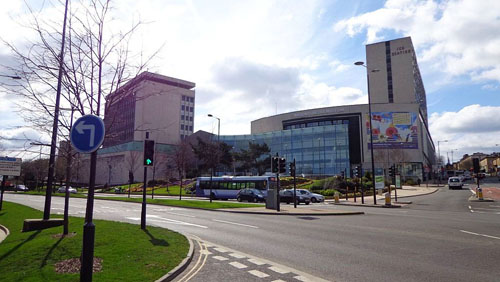 2006 had been the last time I visited
Bradford`s Widescreen Weekend at the British National Media Museum. At the
time, of course, I was particularly impressed by the 3-strip screenings of
"Windjammer" (USA, 1958) - to my delight even in a German language spoken
version - and the all-time hit "How the West Was Won" (USA, 1962). All
projected onto the deeply curved screen in the Pictureville Cinema. 2006 had been the last time I visited
Bradford`s Widescreen Weekend at the British National Media Museum. At the
time, of course, I was particularly impressed by the 3-strip screenings of
"Windjammer" (USA, 1958) - to my delight even in a German language spoken
version - and the all-time hit "How the West Was Won" (USA, 1962). All
projected onto the deeply curved screen in the Pictureville Cinema. Now, 8 years later the great opportunity watching the last two Cinerama `holy grails´ "Seven Wonders of the World" (USA, 1956) and "Search for Paradise" (USA, 1957) on the curved Cinerama screen. That was the reason why I travelled to England. Yes, I had already known, now all digitally restored in its full color glory - a digital reincarnation. In the morning of the 09th April I flew with Easy Jet from Berlin (Germany) to Manchester and on the next day I took a train to Bradford. So, I had the opportunity to enjoy Manchester for nearly a whole day. It is an interesting city with more life than I had expected. I even took a ride on a Ferris wheel in the city`s center with a fantastic view. In Bradford the same hotel as in 2006 - the "Holiday Inn Express" located just around the corner of Bradford`s Interchange Train Station on the side of a big Cineworld Multiplex Cinema. The National Media Museum with its impressive Pictureville Cinema is only around a 12-minute walk away. Here at this point I would like to mention that I have not visited all of the Festival's events. I also needed from time to time outdoor walking and fresh air – although, in the cinema was plenty of fresh air directly coming from the air-conditioning plant. I always needed my warm jacket and above all my scarf. I noticed that the English are much more adapted to cool temperatures than I. |
More in 70mm reading: Widescreen Weekend 2014, images by Ulrich Rostek Widescreen Weekend, Bradford, 2014 2014 Widescreen Weekend Introduction by Wolfram Hannemann Widescreen Weekend "Audience on Stage" Internet link:
|
Here brief descriptions of only some of the listed films: |
|
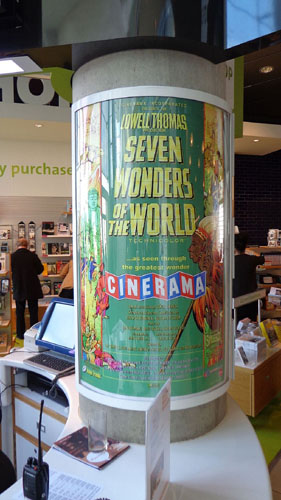 The Festival was opened on Thursday, the 10th, according to my perceived
temperature feeling, with the first film shot in
VistaVision titled "White
Christmas" (USA, 1954) directed by Michael Curtiz. It was introduced by film
historian Tony Sloman. At the time of its release at New York´s
Radio City
Music Hall it was a box Office hit. The numerous Irving Berlin songs and the
dance scenes are stirring. But, in my mind's eye for the present time all is
a little bit old fashioned and schmaltzy? (I don't exactly know the
appropriate English word. Here in Germany we say "kitschig"). The movie was
digitally presented in 2K resolution on the flat screen with a running time
of 120 minutes. I am always happy about Mr Sloman's detailed film
descriptions and his excellent English pronunciation. The Festival was opened on Thursday, the 10th, according to my perceived
temperature feeling, with the first film shot in
VistaVision titled "White
Christmas" (USA, 1954) directed by Michael Curtiz. It was introduced by film
historian Tony Sloman. At the time of its release at New York´s
Radio City
Music Hall it was a box Office hit. The numerous Irving Berlin songs and the
dance scenes are stirring. But, in my mind's eye for the present time all is
a little bit old fashioned and schmaltzy? (I don't exactly know the
appropriate English word. Here in Germany we say "kitschig"). The movie was
digitally presented in 2K resolution on the flat screen with a running time
of 120 minutes. I am always happy about Mr Sloman's detailed film
descriptions and his excellent English pronunciation.Then: "The Big Blue" (Le Grand Bleu, France/USA/Italy, 1988) in 70mm, the original theatrical cut with a running time of 132 minutes projected onto the flat screen. Here in Germany I saw a shorter version of the movie a long time ago. So, a lot of scenes were new to me. This is the special world of enthusiastic "free" divers portrayed by excellent actors. The movie also describes some parts of the human psyche, the longing for love and also sometimes for death. It ran very successfully, above all in France. Really impressive was the 6-channel magnetic sound. The colors were only a little bit faded. On Friday, the 11th, I travelled through the time. I saw the Cinerama movie "Seven Wonders of the World" (USA, 1956) for the first time at the Düsseldorf Cinerama Tonhallen Theater. I think it had been in 1961. Now after more than 50 years again digitally projected onto the Cinerama screen in 2K resolution with a running time of 121 minutes and intermission. David Strohmaier gave an interesting introduction of the European Premiere of the restored travelogue. At the time of the film's premiere (1956) round-the-world trips were not common and so the movie must have been nearly a `wonder´ with a lot of goose bump phenomena, e.g., caused by the impressive landscape shots or the partly powerful score. I think the musical parts composed by Jerome Moross, "The Holy Land", are particularly touching. Of course, also this movie has become old-fashioned in the course of the years. According to my taste the sequences filmed about the Roman Catholic Church in the second part of the movie are too lengthy and at the end there is a little bit too much wonderful `America´. The movie's original 7-channel magnetic sound has been remixed into 5.1 digital sound by Chase Audio in Burbank (California). It sounded great. It has been a great pleasure watching this movie again and I am looking forward to receive the Blu-Ray Edition from Flicker Alley. David Strohmaier and Randy Gitsch are still working on the extras. The festival guests were surprised by a big box in the Pictureville auditorium. It contained a lot of DVD / Blu-Ray Editions released by Flicker Alley from the previously restored Cinerama travelogues and also Soundtrack CDs from "Windjammer" (USA, 1958) and "Cinerama Holiday" (USA, 1955) by Sepia Records. All these things were raffled off among the guests - a really nice gesture. I didn't win - no problem - I have it all. |
|
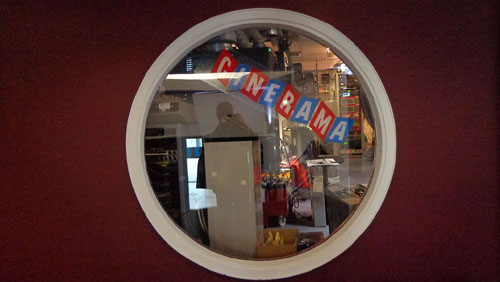 On Friday afternoon Lothar Wolff's Oscar-nominated (best short / 1966)
"Fortress of Peace" (Switzerland, 1964, 20 minutes), filmed in MCS-70 Super
Panorama, was shown on the curved screen. It is excellently done but the
scenes of war and destruction gave me a feeling of unease.
"Fortress of
Peace" is the only a little bit shorter and partly modified version of the
movie "Wehrhafte Schweiz". This film had been produced in Switzerland and
had its premiere at the EXPO 1964 in Lausanne. In the auditorium of the
Swiss Army Pavilion were additionally installed two huge screens,
respectively on the left and the right side of the center screen. Onto these
screens additional scenes (excerpts from 70mm source) were projected. It was
a little bit like Cinerama, but 3 x 70mm. At the time of its release the
movie had been a subject of great controversy because of its martial scenes. On Friday afternoon Lothar Wolff's Oscar-nominated (best short / 1966)
"Fortress of Peace" (Switzerland, 1964, 20 minutes), filmed in MCS-70 Super
Panorama, was shown on the curved screen. It is excellently done but the
scenes of war and destruction gave me a feeling of unease.
"Fortress of
Peace" is the only a little bit shorter and partly modified version of the
movie "Wehrhafte Schweiz". This film had been produced in Switzerland and
had its premiere at the EXPO 1964 in Lausanne. In the auditorium of the
Swiss Army Pavilion were additionally installed two huge screens,
respectively on the left and the right side of the center screen. Onto these
screens additional scenes (excerpts from 70mm source) were projected. It was
a little bit like Cinerama, but 3 x 70mm. At the time of its release the
movie had been a subject of great controversy because of its martial scenes.
Then I paused. At 06.45 pm the Festival's Widescreen Weekend Reception took place on the third floor of the National Media Museum in the room of the "Experience TV" exhibition. We were kindly received with various drinks. For me that was an opportunity to meet some movie enthusiasts for the first time like Mark Lyndon and the enchanting Margaret Weedon, both from London, or only briefly Cinerama Aficionado Tom March from Calgary (Canada). It was also nice to speak with Ulrich Rostek and Wolfram Hannemann (from Laserhotline) - both from Germany. Read Ulrich Rostek`s Hamlet report: http://www.in70mm.com/news/2013/rostek/uk/index.htm |
|
Saturday, the 12th, began with a bang: It was Wolfram Hannemann`s
"Remembering Widescreen" movie introduced by himself in a very funny way. A
37 minutes documentary not only about the organizing of the festivals but
also with a lot of, never boring, interviews with wide-film-buffs mostly
filmed during last year's Widescreen Weekends in the Pictureville Cinema.
All, of course, shot in widescreen format. I hope the short will be released
on DVD / Blu-Ray sometime. Wolfram – very well done, my congratulations. 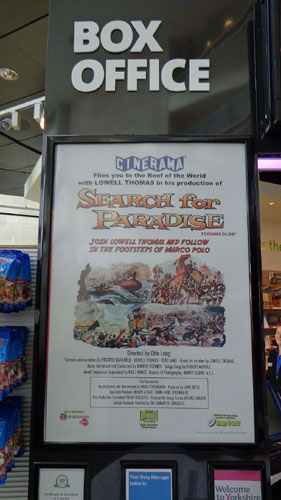 During the following 150 minutes more highlights: We all travelled to
"Paradise" - to "Shangri-La". It began with David Coles` new documentary
"Searching for Paradise" (30 minutes, digital source). Just at the
beginning of the movie the `Cineramaholic´ Coles can be seen, dressed in
wonderful shorts, in John Mitchell's back garden Cinerama theatre near
Sydney (Australia) asking the question: "Is this Shangri-La – the Paradise?"
(I think this may be true for real Cinerama enthusiasts, like John Mitchell
– perhaps also for Coles and me?). This detailed behind-the-scenes look at
Otto Lang's (director) Cinerama film "Search for Paradise" (USA, 1957)
nearly leaves no questions unanswered with never before seen color slides by
production secretary Jane MacLardy. In 2002, Otto Lang (21.01.1908 -
30.01.2006) visited John Mitchell in Australia at the proud age of 94 in
order to watch the movie with the last surviving 3-strip print. During the following 150 minutes more highlights: We all travelled to
"Paradise" - to "Shangri-La". It began with David Coles` new documentary
"Searching for Paradise" (30 minutes, digital source). Just at the
beginning of the movie the `Cineramaholic´ Coles can be seen, dressed in
wonderful shorts, in John Mitchell's back garden Cinerama theatre near
Sydney (Australia) asking the question: "Is this Shangri-La – the Paradise?"
(I think this may be true for real Cinerama enthusiasts, like John Mitchell
– perhaps also for Coles and me?). This detailed behind-the-scenes look at
Otto Lang's (director) Cinerama film "Search for Paradise" (USA, 1957)
nearly leaves no questions unanswered with never before seen color slides by
production secretary Jane MacLardy. In 2002, Otto Lang (21.01.1908 -
30.01.2006) visited John Mitchell in Australia at the proud age of 94 in
order to watch the movie with the last surviving 3-strip print. David Coles - many thanks for your impressive documentary and also for your often funny narrative. The digitally restored Cinerama movie "Search for Paradise" (USA, 1957, runtime 120 minutes, with intermission) followed. It was projected in 2K resolution onto the curved screen. I was very curious to see it for the first time in my life. The movie was introduced by Randy Gitsch (film archivist and producer on the restoration). This is the last Cinerama travelogue that was produced and narrated by Lowell Thomas and it surprised me positively. It has breathtaking shots of Ceylon (now Sri Lanka), Kashmir and the Hunza Valley (Pakistan) and their inhabitants and in the second part great impressions of King Mahendra`s coronation in Kathmandu. I think this movie is really an important historical document. Dimitri Tiomkin`s score is always present and gives the film a certain, sometime also bombastic, flair. At this weekend it was the first time that I enjoyed 3-strip travelogues on the deeply curved louvered screen in the new digital projection process. I must say, I liked it. The pictures were always sharp, with impressive colors. Thanks to "Smile Box" the whole screen was always completely illuminated and even the seams were often invisible. The digital 5.1 sound mix of both films convinced. So, the visit to Bradford was well worth. |
|
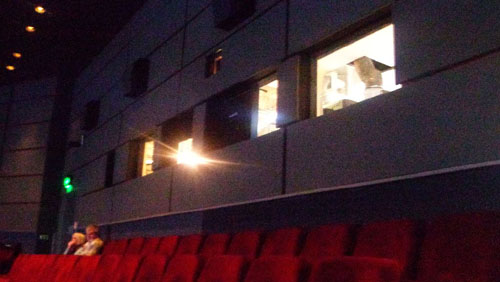 On Saturday evening `I travelled to New York´ in order to see Maria and Tony
and many other singing boys and girls in
"West Side Story" (Robert Wise,
USA, 1961) - all in 70mm, on the curve, 152 minutes with intermission.
Wolfram Hannemann gave a splendid
introduction. In the cinema next to me sat
a friendly elderly couple. The man asked me: "How many times did you already
see the movie?" and I answered: " I know the movie by heart, I don't know".
I told the couple that the screening of "West Side Story" in this cinema
would be a special event because of its unique deeply curved louvered screen
– the only one in Europe. He was amazed - and another highlight: The new
original 6-track sound mix. On Saturday evening `I travelled to New York´ in order to see Maria and Tony
and many other singing boys and girls in
"West Side Story" (Robert Wise,
USA, 1961) - all in 70mm, on the curve, 152 minutes with intermission.
Wolfram Hannemann gave a splendid
introduction. In the cinema next to me sat
a friendly elderly couple. The man asked me: "How many times did you already
see the movie?" and I answered: " I know the movie by heart, I don't know".
I told the couple that the screening of "West Side Story" in this cinema
would be a special event because of its unique deeply curved louvered screen
– the only one in Europe. He was amazed - and another highlight: The new
original 6-track sound mix.The 70mm print of "West Side Story" had been sent in canisters from America to Bradford. Unfortunately some of the canisters / films were damaged during the transport and consequently the 70mm screening was "on the knife's edge". Happily, the destroyed parts of the film were delivered in addition on time. |
|
Sunday, the 13th, was for me the last day in Bradford. I wanted to take the
train at 01.17 pm which would bring me back to Manchester. So I could still
visit the "Cineramacana" event at 10.00 am at the Pictureville Cinema.
People say: "One of the most popular and fun slots events of the weekend".
They presented diverse film sequences and special clips, also hidden
treasures, on the flat and also on the curved screen - all hosted by Duncan
McGregor. For example: John Fernhout`s wonderful MCS-70 short
"Sky over
Holland" (Ciels de Hollande, Netherlands, 1967, 22 minutes, newly
re-mastered). The movie was Oscar-nominated in 1968. In addition there were
shown, among others, 70mm excerpts from "The Lion in Winter" (UK/ USA,
1968), "My Fair Lady" (USA, 1964) and "Camelot" (USA, 1967). One special
highlight was the 3-strip presentation (yes 3 projectors) of an impressive
and well preserved "How the West Was Won" (USA, 1962) trailer.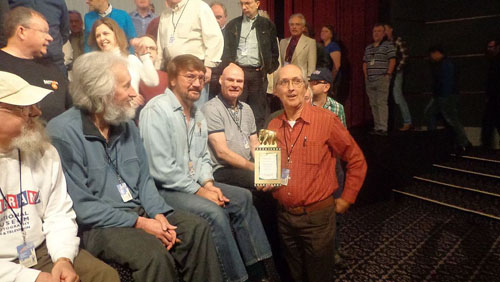 Then came a special moment for
Johan C. M. Wolthuis, the founder of the 70mm
International Association in 1988. This kind man is a "Wide Screen Legend".
In 2013, he became member of the Widescreen Academy. Then came a special moment for
Johan C. M. Wolthuis, the founder of the 70mm
International Association in 1988. This kind man is a "Wide Screen Legend".
In 2013, he became member of the Widescreen Academy. He created the 70mm Publisher`s "Golden Elephant Award". At the end of the "Cineramacana" presentation he honored David Strohmaier and Bill Lawrence, who unfortunately was absent, with his "Elephant Oscar" for their outstanding work. David was visibly moved. This all was rounded up with the annual Audience on Stage meeting and the taking of photographs. |
70mmpublishers.nl |
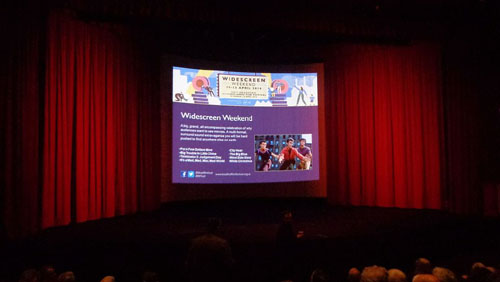 Of course, I would have liked to see the Wide Screen
Weekend's last movie "It's
a Mad, Mad, Mad, Mad World" (USA, 1963) filmed in Ultra Panavision 70 (Super
Cinerama, 192 minutes), presented in 70mm (2:76:1) format on the curved
screen. Unfortunately it was not possible because I had to be back in Berlin
on Monday. Of course, I would have liked to see the Wide Screen
Weekend's last movie "It's
a Mad, Mad, Mad, Mad World" (USA, 1963) filmed in Ultra Panavision 70 (Super
Cinerama, 192 minutes), presented in 70mm (2:76:1) format on the curved
screen. Unfortunately it was not possible because I had to be back in Berlin
on Monday. An event at which I did not participate: Professor Sir Christopher Frayling gave on Saturday, the 12th, an illustrated presentation titled "The Widescreen Aesthetics of Sergio Leone". From the program: "Numerous spaghetti westerns utilized the widescreen Techniscope format to dazzling effect and Christopher Frayling will cover the use of this and how the look and style created a different dynamic to the conventional western." Here at the end of the report I should also like to express my thanks to the staff of the Pictureville Cinema for their friendly welcome. |
|
More images |
|
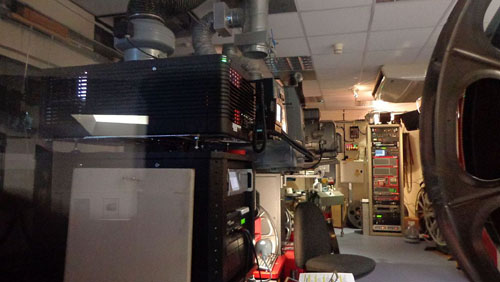 |
|
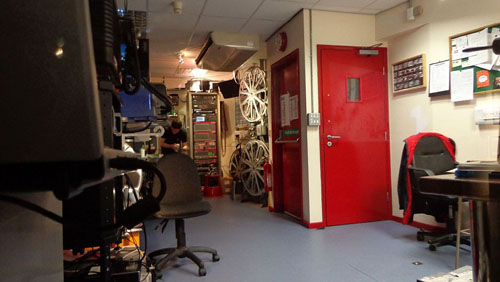 |
|
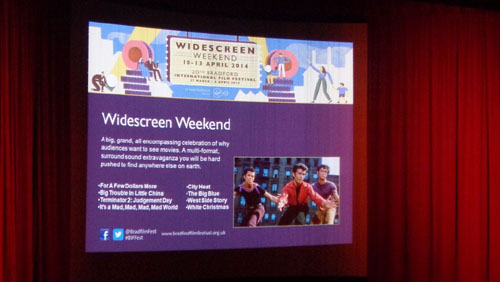 |
|
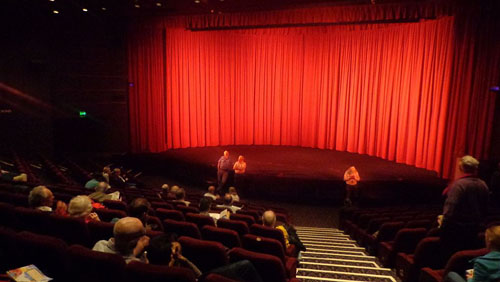 |
|
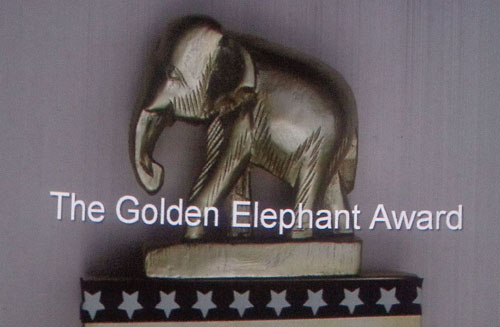 |
|
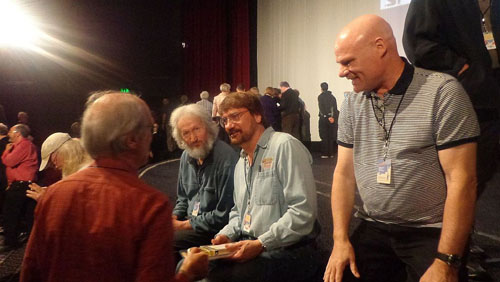 |
|
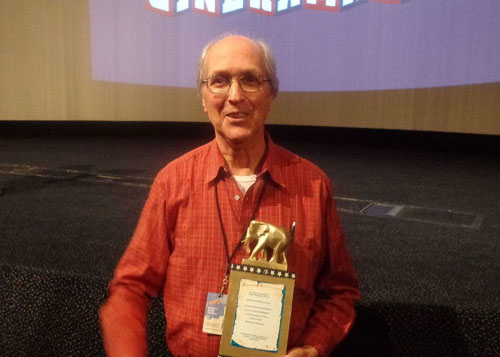 |
|
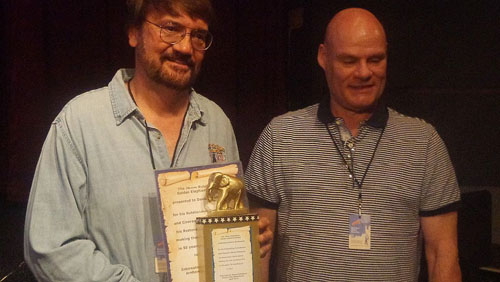 |
|
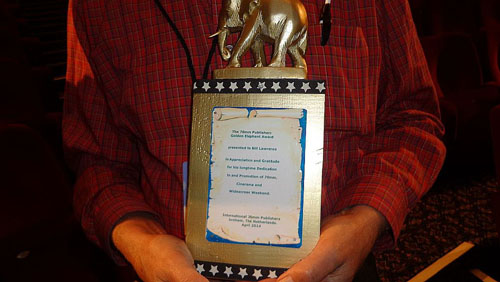 |
|
| Go: back - top - back issues - news index Updated 22-01-25 |
